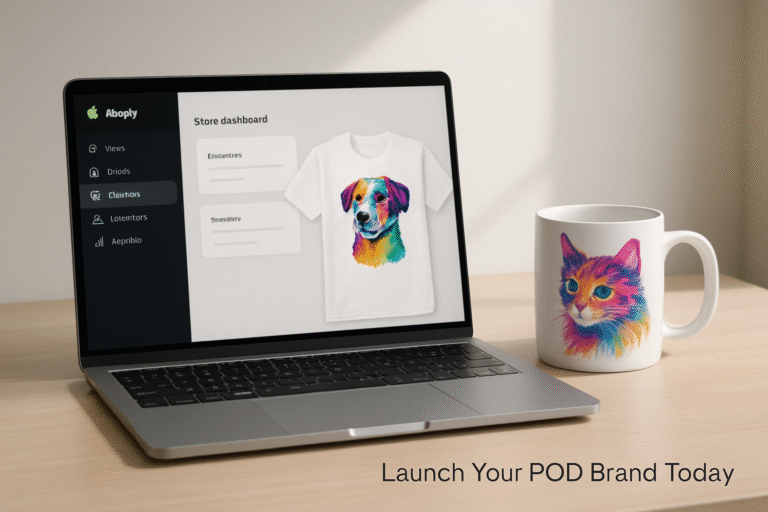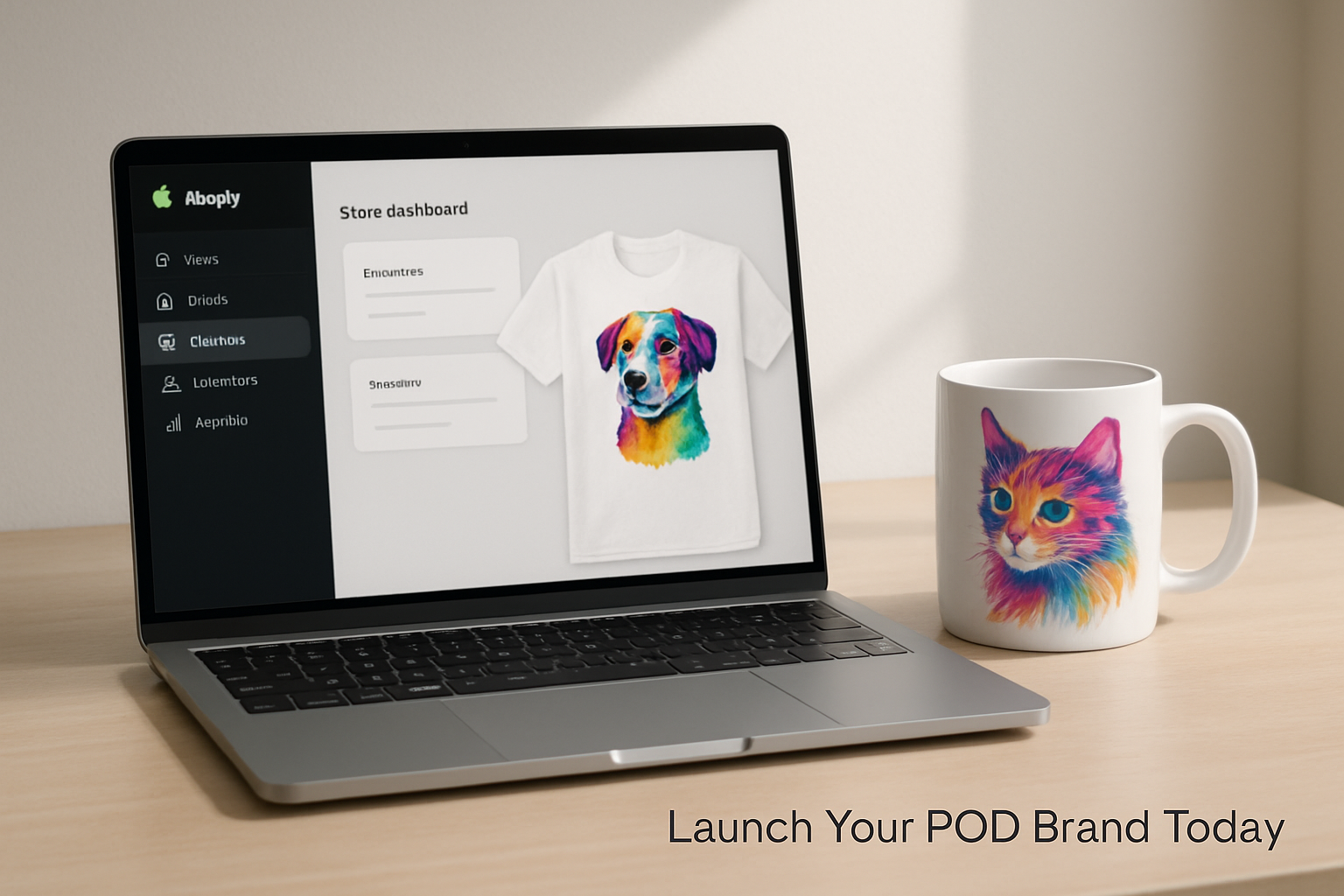
Print on demand (POD) is a business model where products are created only after a customer places an order. This means no need to hold inventory, no bulk orders, and no unsold merchandise piling up in storage. Once a design is created and uploaded to an online store, a third-party supplier prints and ships the item directly to the customer, while the entrepreneur earns a profit. The simplicity and flexibility of running a POD business make it an attractive option for students, side hustlers, and anyone eager to earn money online without the complexities of traditional retail.
One major advantage of POD is the ability to operate from virtually anywhere. Whether working from home in comfortable attire or relaxing at a beach, entrepreneurs can manage their store with minimal logistical challenges. The range of products is diverse, extending beyond the typical t-shirt to mugs, posters, tote bags, pillows, and even sneakers, providing ample opportunities to match customer preferences and expand market reach.
Exploring the Print on Demand Market Growth
The POD market has experienced significant expansion. Current research values the global POD market at around $6 billion, with projections estimating it could exceed $40 billion by 2031. This rapid growth highlights the expanding demand and opportunities available to those entering the space. Notably, large-scale brands are not the only entities benefiting; individual entrepreneurs are successfully generating substantial income through POD.
For instance, Printful, a prominent POD platform, was born from the founder’s need for reliable printing services. Initially operating as a motivational poster business called Startup Vitamins, the founder developed Printful to solve industry challenges. Today, it stands as one of the leading POD services globally, illustrating how new platforms continue to support a growing number of online sellers.
Five Essentials to Launch Your Print on Demand Business
Starting a POD business requires focus on five critical components that form the foundation for success:
1. Selecting a Winning Product: Not all POD items yield the same profit margins or customer interest. Choosing the right product with potential for substantial returns is essential.
2. Creating a Great Design: The product itself needs compelling visuals or messaging. A plain white t-shirt is unlikely to attract attention without an engaging design.
3. Establishing a Selling Platform: Utilizing Shopify to set up an online store offers control over brand presentation, pricing, and customer experience.
4. Partnering with a Reliable Supplier: Since the supplier handles printing and shipping, quality and timeliness directly impact customer satisfaction.
5. Attracting Paying Customers: A store without visitors or buyers has little value. Marketing efforts must drive traffic and convert visits into sales.
With these elements in place, newcomers gain a head start and avoid common pitfalls encountered by beginners.
Choosing a Winning Product for Print on Demand
Selecting the right product category is fundamental for success. Each product offers distinct profit margins, appeal, and market saturation levels. The formula for a winning product involves pairing a solid product category with a well-designed item. Neither element on its own guarantees success; a great design on a poor product will not perform well, nor will a mediocre design on a popular product.
Begin with one product type to refine expertise before diversifying. Focus on items that customers already search for, as unfamiliar or obscure products may struggle to sell. Keep product variants manageable to avoid overwhelming customers.
Top-performing product categories for POD include wall art and clothing. Posters, canvas prints, and t-shirts often provide healthy markups, while accessories such as phone cases and tote bags enjoy steady demand. Understanding your target market’s preferences aids in selecting products with the best chance to succeed.
Identifying the Right Niche for Success
Beyond choosing the product, finding a profitable niche is a key determinant of sales performance. People purchase items that align with their identity, interests, and communities. For example, a generic tote bag may have limited appeal, whereas a tote bag featuring a humorous insider joke for nurses is likely to resonate strongly within that professional group.
Potential niches span hobbies, occupations, fandoms, and popular culture trends. Examples include dog lovers, fitness enthusiasts, or avid readers. It is vital to avoid trademark infringement by ensuring designs do not improperly use protected logos or copyrighted content.
Researching existing bestseller trends on platforms like Etsy or Amazon and exploring Pinterest search patterns helps identify underserved audiences or fresh angles for designs. A well-defined niche not only simplifies marketing efforts but can also encourage repeat customers.
Design Creation Options for Print on Demand
Designs play a significant role, and fortunately, extensive options exist to accommodate different skill levels and budgets:
– Purchasing Ready-Made Designs: Websites such as Creative Market and Vexels offer high-quality design packs ready to use.
– Using AI Tools: Artificial intelligence platforms like MidJourney enable users to generate unique artwork by inputting descriptive prompts.
– Hiring Professional Designers: Freelance platforms like Fiverr and Upwork provide access to custom design services.
– Creating Your Own Designs: For those with graphic design skills, creating original designs can be a rewarding option.
Each method provides a way to obtain compelling visuals tailored to specific audiences, making the design process accessible regardless of prior experience.
Setting Up a Shopify Store for Your Business
Having a dedicated Shopify store empowers entrepreneurs with control over branding, pricing, and the shopping experience. Unlike third-party marketplaces, Shopify allows shop owners to own their customer journey fully, without the risk of sudden policy changes or unexpected fees.
Setup is straightforward: select a professional theme, upload product listings, configure payment options, and publish the store. Shopify also integrates smoothly with leading POD suppliers, enabling seamless synchronization of orders and fulfillment.
Establishing a store early fosters long-term brand development and higher profit margins. For those new to Shopify, tutorials and guides are widely available to facilitate the entire setup process.
Selecting the Best Print on Demand Supplier
The choice of POD supplier is crucial since quality prints, reliable shipping, and timely fulfillment impact overall customer satisfaction. Some of the leading POD platforms include:
– Printful: Renowned for premium product quality, excellent customer support, and diverse branding options.
– Printify: Offers an extensive product catalog with various print providers, competitive pricing, and integrated online design tools.
– Guten: Specializes in apparel, wall art, home decor, and accessories, suitable for expanding beyond clothing.
– Appleique: Focuses on custom streetwear, private labels, and high-end embroidery options.
– Spread Connect: Prioritizes speedy fulfillment and efficient shipping.
– Tea Launch: Features unique products such as engraved tumblers and headphones.
– Custom Cat: Known for wide product selection and dependable customer service.
– Teapop: Provides eco-friendly and sustainable product options.
– Jetprint: Offers accessories like shoes and jewelry along with professional photography services.
– AOP (All Over Print): Handles in-house printing and fulfillment.
– Modelist: Caters to boutique apparel brands with fast delivery.
– Lulu Express: Perfect for self-publishing books, journals, and planners.
– Gelato: Operates a global print network with eco-friendly, fast fulfillment.
A practical tip is to order samples before committing to a supplier. Testing products firsthand ensures quality meets expectations and prevents potential customer complaints.
Top Print on Demand Products to Sell
Reliable product choices can help newcomers avoid uncertainty. Based on market data, the following products consistently perform well:
1. T-Shirts: The best-selling product with versatility and low production costs. Designs inspired by social trends and memes can boost sales.
2. Hoodies and Sweatshirts: Slightly higher ticket items with strong demand.
3. Hats: Including embroidered dad hats and beanies, often overlooked but popular.
4. Bags: Particularly eco-friendly and customizable totes.
5. Phone Cases: Affordable, easy to ship, and perfect for personalization or pop culture designs.
6. Personalized Jewelry: Lightweight, stylish, and great for gifts with initials or custom art.
7. Posters and Canvas Prints: High-profit, low-hassle wall art options featuring quotes or niche themes.
8. Mugs: While margins per mug are lower, volume sales are solid, especially with humorous or personalized designs.
9. Drinkware: Tumblers and custom bottles increasingly popular for their utility and personalization opportunities.
10. Notebooks and Stickers: Low cost, highly customizable, and perfect for bundling.
Aligning product choice with niche preferences enhances the chance of success.
Strategies for Product Selection and Marketing
Choosing appropriate products involves balancing evergreen items with trending pieces. Evergreen products, such as t-shirts and mugs, sell consistently year-round, while trending items can generate rapid spikes in sales.
- Identify products with high demand in the market to ensure steady sales.
- Choose suppliers that offer easy and reliable production and shipping processes.
- Develop a unique selling point to differentiate your print on demand products from competitors.
- Focus on quality designs that appeal to your target audience.
- Optimize your online store for user experience and conversion rates.
- Utilize social media marketing to increase brand visibility and attract customers.
- Monitor trends and adjust your product offerings accordingly.
- Provide excellent customer service to build trust and encourage repeat business.
Innovative marketing tailored to niche audiences is vital. Clear understanding of target customers’ interests, combined with unique design approaches, can distinguish a store in a crowded marketplace.
Leveraging AI for Personalized Print on Demand Products
Personalization has become a key factor for standing out. Artificial intelligence tools can create hyper-personalized products quickly. For example, customers can upload a photo of their pet, and AI transforms it into custom digital artwork, ready to print on various products like mugs or canvases.
Tools such as Deep Dream Generator for pet portraits or MidJourney for unique art generation enable high-quality custom designs, adding value by offering products that feel one-of-a-kind. This kind of customization appeals strongly to buyers seeking meaningful items.
Building a Brand with Print on Demand
Success in POD extends beyond individual sales. Combining intelligent product choices, captivating design, and personalized elements lays the groundwork for building a distinctive brand. A thoughtful approach to branding increases customer loyalty, repeat business, and long-term profitability.
Building a brand involves consistent messaging, memorable visual identity, and superior customer experience. Utilizing a platform like Shopify facilitates such efforts by providing control over every aspect of the customer journey.
Print on demand offers an accessible route to entrepreneurship, requiring minimal upfront investment while enabling creativity and flexibility. Understanding these core principles equips anyone interested in launching a POD venture with the tools to get started and grow effectively.
